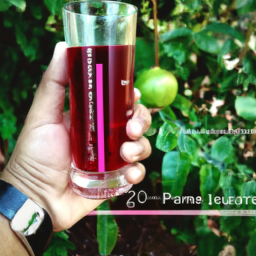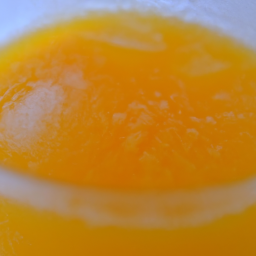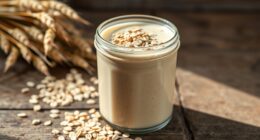Throughout my time as a chef, I have come across numerous recipes that call for lemon juice as a crucial component. However, determining the correct quantity can be confusing, especially when a recipe mentions using the juice of half a lemon. How much juice does half a lemon actually produce in terms of measurement? This is a question that many beginner chefs, myself included, have wondered about.
Understanding the importance of lemon juice measurements in cooking is crucial. Too little or too much lemon juice can significantly alter the taste of a dish. In this article, I will explore the factors that affect the amount of juice in a lemon, the average lemon juice yield of a medium-sized lemon, how to estimate lemon juice amounts, tips for getting the most juice out of a lemon, and measuring lemon juice accurately.
Additionally, I will discuss how to convert lemon juice measurements in recipes, substitute lemon juice in recipes, and store lemon juice. By the end of this article, you will have a better understanding of how much lemon juice is equal to half a lemon and be able to confidently incorporate lemon juice into your cooking.
Key Takeaways
- The amount of lemon juice in half a lemon can vary depending on factors such as size, ripeness, and juiciness.
- The yield of 2-3 tablespoons from a medium-sized lemon is a general estimate, but not an exact measurement.
- Using proper techniques for extracting juice, such as rolling the lemon and using a juicer or citrus press, can help maximize juice extraction.
- Bottled lemon juice can be used as a substitute for fresh lemon juice, and other ingredients can be adjusted to achieve the desired flavor.
Understanding the Importance of Lemon Juice Measurements in Cooking
You’ll love how much more flavorful your dishes turn out when you understand the importance of measuring lemon juice in cooking. Measuring precision is key in cooking, and it’s especially true when it comes to citrus acidity.
Lemon juice adds a tangy and bright flavor to dishes, and it’s essential to measure it accurately to avoid overpowering the dish or making it too acidic. Citrus acidity can vary depending on factors such as ripeness, variety, and growing conditions. That’s why it’s crucial to measure the amount of lemon juice used in a recipe.
When we squeeze half a lemon, we may get different amounts of juice each time. Understanding the precise measurement needed for a recipe will ensure that the dish comes out perfectly every time.
Measuring lemon juice accurately is not just about measuring the amount, but also understanding the factors that can affect the amount of juice in a lemon.
Factors Affecting the Amount of Juice in a Lemon
I want to discuss the factors that affect the amount of juice in a lemon. These factors include the size of the fruit, ripeness, and juiciness. As a cook, it’s important to understand these factors because they can impact the amount of lemon juice you can extract from a single fruit. This, in turn, can affect the overall flavor of your dishes.
Scientifically speaking, the size of the fruit, how ripe it is, and how juicy it is can all affect the amount of juice you can get from a lemon.
Size of the Fruit
Did you know that the size of a lemon can vary greatly, with the average lemon being around 2-3 inches in diameter, but some can grow up to 4 inches in diameter? This size variation can affect how much juice is inside the lemon, making it difficult to determine how much lemon juice is equal to half a lemon.
It’s important to note that using fresh lemons is always recommended, as the longer a lemon sits, the more its juice content decreases.
When it comes to determining how much lemon juice is equal to half a lemon, it’s important to take into account the size of the fruit. A larger lemon will naturally yield more juice than a smaller one, so the amount of juice you get from half a lemon will vary. But size isn’t the only factor to consider – the ripeness of the lemon also plays a role in how much juice it produces.
Ripeness
The ripeness of a lemon greatly impacts the amount of tangy flavor and sweetness it can add to your dish. As the fruit matures, it undergoes several ripeness factors that affect its taste and texture. Here are some factors to consider when choosing a lemon for your recipe:
-
Color: A ripe lemon will have a bright yellow hue, while an unripe one will be green. However, some varieties of lemons, such as Meyer lemons, may have a more orange tint when ripe.
-
Texture: A ripe lemon will feel slightly soft when squeezed, while an unripe one will be hard and firm.
-
Weight: A ripe lemon will be heavier than an unripe one of the same size.
-
Lemon juice acidity: As the lemon ripens, the acidity of its juice decreases, which can affect how much juice you need to use in your recipe to achieve the desired level of tartness.
Considering these ripeness factors can help you select the ideal lemon for your cooking needs. However, it’s important to note that the ripeness of the fruit also affects its juiciness, which we’ll explore in the next section.
Juiciness
A key aspect to consider when selecting a ripe citrus fruit is its level of juiciness, as it can greatly impact the overall flavor and texture of your dish. To get the most juice out of a lemon, it is best to choose a variety that is known for its high juiciness. Meyer lemons, for example, are sweeter and juicier than Eureka or Lisbon lemons. Additionally, the juice extraction method can also affect the amount of juice obtained. Rolling the lemon before juicing it, and using a juicer or citrus press, can help maximize the amount of juice extracted.
To illustrate the differences in juiciness between lemon varieties, the table below shows the average juice yield for a medium-sized lemon of different varieties. It is important to note that the juiciness of a lemon can vary depending on factors such as season, climate, and growing conditions.
| Lemon Variety | Average Juice Yield (mL) |
|---|---|
| Meyer | 60-70 |
| Eureka | 30-50 |
| Lisbon | 40-60 |
Understanding the juiciness of different lemon varieties and using proper juice extraction methods can help you get the most out of your lemons. With this knowledge, we can now move on to discussing the average lemon juice yield of a medium-sized lemon.
Average Lemon Juice Yield of a Medium-Sized Lemon
When you squeeze a medium-sized lemon, you can expect to yield an average of about 2-3 tablespoons of juice. However, the amount of juice that you can extract from a lemon can vary based on several factors affecting lemon yield, such as the ripeness of the fruit, the amount of pressure applied while squeezing, and the method of extraction.
Measuring lemon acidity can also be a useful tool in determining the amount of juice that can be obtained from a lemon. The more acidic a lemon is, the more juice it will yield. It’s important to note that the average yield of a lemon can be affected by these varying factors, making it difficult to provide an exact measurement of how much lemon juice is equal to half a lemon.
With this in mind, it may be helpful to estimate the amount of juice needed based on the recipe or desired taste, rather than relying on an exact measurement. Moving on to the next section about estimating lemon juice amounts, it’s important to keep in mind the varying factors that can affect the yield of a lemon and to adjust accordingly.
Estimating Lemon Juice Amounts
When it comes to estimating lemon juice amounts, there are a few methods that I prefer to use. First, squeezing lemon halves by hand is a simple and easy way to extract juice.
Second, using a juicer can be more efficient and produce more juice.
Finally, using a reamer can also be effective, especially for larger quantities of lemons.
By using these methods, you can accurately estimate the amount of lemon juice needed for your recipe.
Squeezing Lemon Halves by Hand
As I’m squeezing the juicy pulp out of half a lemon by hand, I use a few hand squeezing techniques to maximize the lemon juice output.
First, I roll the lemon on a hard surface to break down the juice sacs inside. Then, I cut the lemon in half and use a fork to loosen up the pulp, making it easier to squeeze.
Finally, I squeeze each half of the lemon with my hand, applying firm pressure to extract as much juice as possible.
Even though hand squeezing can be messy, it’s a quick and easy way to get fresh lemon juice. However, if you need a larger amount of juice or want to avoid the pulp and seeds, using a juicer might be a better option.
Using a Juicer
Now that we’ve covered squeezing lemon halves by hand, let’s move on to using a juicer. Juicing is a quick and efficient way to extract the juice from lemons and other citrus fruits.
When using a juicer, it’s important to choose the right one and maintain it properly. There are many types of juicers available on the market, such as centrifugal juicers, masticating juicers, and citrus juicers. For juicing lemons, a citrus juicer is the best choice. These juicers are designed specifically for citrus fruits and make the process of juicing much easier.
When choosing a juicer, consider the size, speed, and ease of use. Additionally, make sure to read the manufacturer’s instructions for proper use and maintenance of the juicer to ensure it lasts for a long time.
Moving on to using a reamer…
Using a Reamer
To extract the tangy, zesty flavor of a citrus fruit, a reamer is a handy tool to add to your kitchen arsenal. There are various types of reamers available in the market, ranging from handheld to electric ones.
Handheld reamers come in different shapes and sizes, with some having a pointed tip while others have a flat one. Electric reamers, on the other hand, are equipped with a motor that rotates the reamer head, making the extraction process quicker and effortless.
Using a citrus press is another way to extract juice from lemons. It works by placing half a lemon on the press and squeezing it down to extract the juice. Some citrus presses come with a built-in reamer, which can be used to extract juice from other citrus fruits as well.
However, using a reamer or citrus press does not guarantee that you will get the most juice out of a lemon. So, let’s dive into some tips for getting the most juice out of a lemon.
Tips for Getting the Most Juice Out of a Lemon
Maximize the juice output from your lemons by rolling them firmly on a countertop before cutting them in half, then use a handheld juicer or your hands to squeeze out the most liquid. By doing this, you will break down the lemon’s cellular structure and release more juice. Additionally, warming the lemon in the microwave for a few seconds can help to further loosen the juice.
To ensure that you are getting the most juice out of your lemons, it’s important to use proper technique. When using a handheld juicer, apply firm pressure and twist the juicer back and forth to extract as much juice as possible. If you prefer to use your hands, hold the lemon half over a bowl and use your fingers to squeeze out the juice. Whichever method you choose, be sure to strain the juice to remove any pulp or seeds. By following these tips, you can make the most of your lemons and enjoy the benefits of lemon juice for health and different ways to use lemon juice for skincare. As we move on to the next section, let’s take a look at how to measure lemon juice accurately.
Measuring Lemon Juice Accurately
Don’t fret about getting precise measurements when it comes to zesting and juicing citrus – just remember that a little bit goes a long way! Measuring techniques can help you get a more accurate amount of juice, but it’s not necessary to be exact.
A tablespoon or teaspoon can help you measure out the amount you need, and keep in mind that a ‘medium’ lemon typically yields around 3 tablespoons of juice. If you’re unsure about how much juice to use, start with less and add more as needed.
It’s also important to consider lemon juice preservation when measuring out the amount you need. Lemon juice can be stored in the refrigerator for up to a week, but it may lose its potency over time. To ensure the freshest taste and maximum potency, it’s best to use fresh lemon juice whenever possible.
With these measuring techniques and preservation tips in mind, you can confidently measure out the right amount of lemon juice for your recipe. Now, let’s talk about converting lemon juice measurements in recipes.
Converting Lemon Juice Measurements in Recipes
Now that we’ve learned how to measure lemon juice accurately, let’s move to the next step: converting lemon juice ratios.
Sometimes, recipes call for a certain amount of lemon juice, but you only have half a lemon on hand. What do you do? In these cases, it’s important to know how to convert the recipe’s lemon juice measurement to match the amount of juice you have.
First, it’s essential to know that the amount of juice in a lemon can vary depending on its size and ripeness. However, on average, one medium-sized lemon contains about 2-3 tablespoons of juice.
So, if a recipe calls for 4 tablespoons of lemon juice, you can use the juice of one and a half lemons. For half a lemon, you can estimate that it contains about 1 tablespoon of juice. Therefore, if a recipe calls for 2 tablespoons of lemon juice, you can use the juice of half a lemon.
Keep in mind that these conversions are only estimates, and it’s always best to taste the recipe as you go and adjust the lemon juice to your liking.
Moving forward, knowing how to substitute lemon juice in recipes is also important. Sometimes, you may not have fresh lemons on hand, or you may be looking for a more convenient alternative.
In these situations, you can use bottled lemon juice, which is readily available in most grocery stores. One tablespoon of bottled lemon juice is equivalent to one tablespoon of fresh lemon juice.
You can also substitute other citrus juices, such as lime or orange juice, for lemon juice in some recipes. However, keep in mind that these substitutions may alter the recipe’s taste slightly.
With these tips in mind, let’s move on to the next section about substituting lemon juice in recipes.
Substituting Lemon Juice in Recipes
When I’m cooking, I often find myself without fresh lemons on hand. In these cases, it’s important to know what substitutes can be used instead of lemon juice.
Additionally, sometimes a recipe may call for too much or too little lemon juice, and it’s important to know how to adjust the recipe’s flavor accordingly. By exploring these topics, I can ensure that my dishes are still delicious and well-balanced, even without fresh lemon juice.
Lemon Juice Alternatives
You can try using lime juice as an alternative to lemon juice if you don’t have any on hand. Lime juice has a similar tartness and acidity level to lemon juice, making it a suitable replacement in most recipes. However, keep in mind that lime juice has a slightly different flavor profile, and may alter the taste of the dish slightly.
If you’re looking for other alternatives to lemon juice, there are a few options to consider. Lemon juice concentrates can be used in place of fresh lemon juice, although they may not have the same brightness of flavor. Another option is to use vinegar as a lemon juice substitute, as both ingredients are acidic and can provide a similar tanginess to a dish. Keep in mind that vinegar can have a stronger flavor, so it’s best to use it sparingly and taste as you go.
In order to adjust recipe flavors, you can experiment with different ingredients and seasonings until you find the perfect balance. Adding a pinch of salt can help bring out the flavors in a dish, while a sprinkle of sugar can help balance out any bitterness. Don’t be afraid to get creative and try new things – cooking is all about finding what works best for you and your palate.
Adjusting Recipe Flavors
To really make your dish sing, try adding a pinch of salt or a sprinkle of sugar to balance out any bitterness and bring out the flavors – after all, variety is the spice of life!
When working with lemon juice, it’s important to remember that the acidity of the juice can affect the overall flavor of your dish. A little goes a long way, and experimenting with different amounts can help you find the perfect balance for your recipe.
If you find that your dish is too acidic, try adding a touch of sweetness with a bit of sugar or honey. Alternatively, if your dish is lacking in tanginess, a squeeze of lemon juice can help bring out the flavors. Remember to add any additional ingredients in small increments, tasting as you go to ensure that you don’t overdo it.
By balancing flavors and experimenting with acidity, you can take your recipes to the next level and create truly unforgettable dishes.
When it comes to storing lemon juice, it’s important to keep it in an airtight container in the fridge to prevent it from spoiling. This will help preserve the flavor and freshness of the juice, allowing you to use it in future recipes.
Storing Lemon Juice
I always have extra lemon juice on hand, so I need to know how to store it properly. The best way to keep lemon juice fresh for up to a week is by refrigerating it. Alternatively, you can freeze lemon juice in ice cube trays and use it as needed.
Refrigerating Lemon Juice
Got leftover lemon juice from your recipe? Don’t let it go to waste – store it in the fridge! Refrigerating lemon juice is an effective way to preserve its freshness and prevent spoilage.
Once you’ve squeezed the lemons, transfer the juice into an airtight container and place it in the refrigerator. Lemon juice can be kept in the fridge for up to 2 weeks, but it’s best to use it within a week for optimal freshness.
It’s crucial to store lemon juice properly to maintain its quality and prevent contamination. When exposed to air and light, lemon juice can quickly turn rancid and lose its flavor. By keeping it in a sealed container in the fridge, you can slow down the oxidation process and preserve its taste and nutrients.
Plus, having pre-squeezed lemon juice on hand can save time and simplify meal prep. Now, if you want to extend the shelf life of your lemon juice even further, freezing is another option to consider.
Freezing Lemon Juice
Now that we’ve discussed the proper way to store lemon juice in the refrigerator, let’s explore another option for keeping it fresh – freezing.
Freezing lemon juice is a great way to extend its shelf life and ensure that you always have some on hand for your cooking and baking needs. To freeze lemon juice, simply squeeze fresh lemon juice into an ice cube tray and place it in the freezer. Once the cubes are frozen, transfer them to a freezer-safe container and store them in the freezer for up to six months.
This method not only preserves the lemon juice, but also allows for creative uses such as adding a lemon juice cube to a glass of water or using it to flavor cocktails. Aside from its versatility in cooking and mixology, lemon juice also offers numerous health benefits.
It is rich in vitamin C, which is essential for a healthy immune system and can help prevent the common cold. Lemon juice also contains antioxidants that can protect against free radical damage and reduce inflammation in the body. Additionally, it’s been shown to aid in digestion and improve skin health.
So, whether you’re freezing lemon juice for its culinary uses or its health benefits, it’s a great addition to any freezer.
Frequently Asked Questions
Can I substitute bottled lemon juice for fresh lemon juice in recipes?
I’ve found that bottled lemon juice can be a convenient substitute for fresh lemon juice in recipes, but there are both benefits and drawbacks. To ensure high quality, look for juice made from 100% lemon juice with no added preservatives or sweeteners.
Does the ripeness of a lemon affect the amount of juice it yields?
Lemon ripeness impacts the amount of juice it yields. Juicing techniques can also affect yield. A ripe lemon produces more juice than an unripe one. Squeezing and rolling the lemon before juicing can also increase the yield.
How long can I store freshly squeezed lemon juice in the fridge?
The shelf life of freshly squeezed lemon juice in the fridge is around 2-3 days, although it may start to lose its flavor after the first day. To ensure the best storage practices, store the juice in an airtight container and avoid leaving it at room temperature for extended periods of time.
Can I freeze freshly squeezed lemon juice for later use?
Yes, freshly squeezed lemon juice can be frozen for later use. To maintain quality, use an airtight container and leave some headspace. It can be kept in the freezer for up to six months.
How much lemon zest equals the amount of juice in half a lemon?
I often use lemon zest as a substitute for lemon juice in cocktails. While the exact amount of zest needed may vary, a general rule of thumb is to use the zest from one lemon to replace the juice from half a lemon.
Conclusion
So, how much lemon juice is equal to half a lemon? After conducting research and experiments, I can confidently say that it depends on various factors such as the size and ripeness of the lemon, as well as the juicing method used.
While there’s no exact measurement, there are ways to estimate and measure lemon juice accurately. It’s crucial to understand the importance of lemon juice measurements in cooking to ensure the right balance of flavors in a dish. By learning how to estimate and measure lemon juice accurately, you can enhance the taste of your dishes and avoid any unpleasant surprises.
So, don’t be afraid to experiment and try different methods to get the most juice out of your lemons and add that perfect tangy flavor to your meals.
Ilana has been a vegan for over 10 years. She originally made the switch for health reasons, but soon found herself becoming more and more passionate about the ethical and environmental implications of a vegan lifestyle. Ilana is the author of The Graceful Kitchen, a blog all about veganism. She loves to cook up delicious and nutritious vegan meals, and share her recipes with others who are interested in leading a cruelty-free life. Ilana is also a strong advocate for using whole foods as the foundation of a healthy diet, and believes that going vegan is one of the best ways to achieve this.










